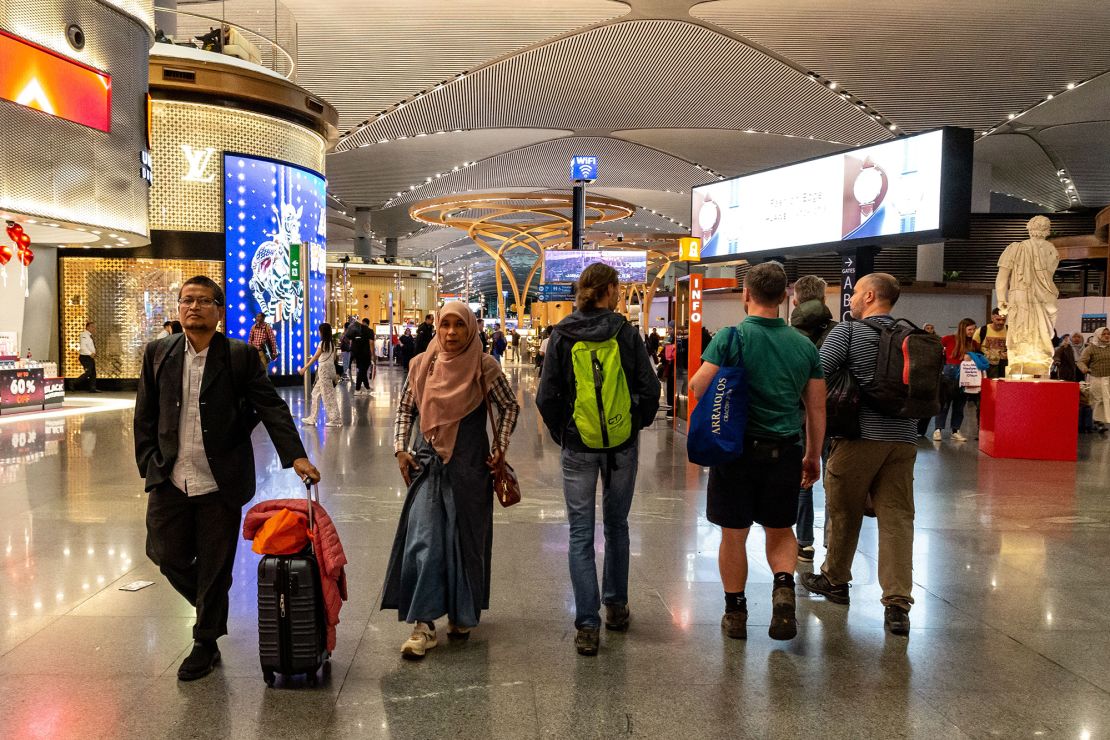CNN
—
Air traffic is officially back.
In 2024, global passenger numbers finally surpassed 2019 levels, after years of ripples from the massive disruption caused by the Covid-19 pandemic.
There were about 9.5 billion passengers globally last year — a 3.8% gain from pre-pandemic levels in 2019 and a 9% increase over 2023, according to preliminary global airport data released on Monday by Airports Council International (ACI) World. ACI represents the interests of 2,181 airports in 170 countries.
“We’re very happy to see that the traffic is back, and we’re anticipating significant growth moving forward right now, even with some of the headwinds that we’re seeing,” Justin Erbacci, ACI World director general, told CNN Travel.
The world’s busiest airport is once again Hartsfield-Jackson Atlanta International Airport. The Delta Air Lines hub in Georgia’s capital city has held the No. 1 spot for 26 of the last 27 years, slipping from its top ranking once in 2020 as passenger traffic cratered.
The No. 2 airport, Dubai International Airport, became the second-busiest airport in the world for the first time in 2023 and retained that position in the latest top 10 rankings.
At No. 3, traffic at Dallas Fort Worth International Airport jumped up 17% in 2024 from 2019 levels and increased more than 7% from 2023. Tokyo Haneda and London Heathrow — frequent top 10 airports — came in at No. 4 and No. 5, respectively.
At No. 6, Denver International Airport serves as an example of strong passenger volume at US hubs, with a more than 19% increase from its 2019 passenger level and a nearly 6% increase from 2023.
“Coming out of the pandemic, we saw that the hub airports in the US grew very fast, actually even during the pandemic, because the major airlines were emphasizing their hubs,” Erbacci said.
The airports in Istanbul, Turkey, and New Delhi, India — Nos. 7 and 9, respectively — “have been thriving due to airline expansion, infrastructure growth and enhanced global connectivity,” according to an ACI World news release.

At No. 8, passenger volume at Chicago O’Hare International Airport is still down about 5% from 2019 levels (up about 8% from 2023) but is “building up for higher growth,” Erbacci said.
And rounding out the top 10 in the 2024 rankings is Shanghai Pudong International Airport, which saw the biggest jump in the rankings — going from No. 21 in 2023 up to No. 10, with a whopping 41% increase in traffic.
The airport’s substantial jump was driven by “expanded visa policies, the resumption and expansion of international flights, operational enhancements, and the recovery of the Asia-Pacific region, particularly China,” according to ACI World.
Atlanta seems poised to retain its top spot, although its 2024 traffic — about 108 million passengers — was still about 2% below its 2019 passenger volume.
“We foresee Atlanta to be maintaining its high position for a while,” Erbacci said, but the most future growth is expected in other regions.
“You’ll continue to see more significant growth in the Asia Pacific, India, China, Latin America regions, to some extent Africa as well. And we’ll see less prominent growth — but nonetheless still growth — in the developed countries in North America and Europe,” he said.
ACI cited economic uncertainty, geopolitical tensions, production delays from aircraft manufacturers and other strains among the challenges the industry faced in 2024. But ACI World’s outlook remains positive.
“I think that we’re seeing the continued resiliency of passenger travel, even with some major global disruptions,” said Erbacci.
There’s still geopolitical and economic uncertainty ahead, and Erbacci expects these forces will have some impact on air travel. How much impact — on areas such as airline capacity or passenger demand — remains to be seen.
“Obviously, if the uncertainty and the tariffs and everything continues … it could impact the growth that we’re projecting right now,” Erbacci said in an interview last week prior to President Donald Trump’s pause on the latest round of US tariffs.
ACI World will be monitoring global developments closely.
“But the prognosis for further growth is high, and we anticipate that our traffic numbers will double by 2045,” Erbacci said.
1. Hartsfield-Jackson Atlanta (ATL): 108.1 million passengers; up 3.3% from 2023
2. Dubai (DBX): 92.3 million passengers; up 6.1% from 2023
3. Dallas Fort Worth (DFW): 87.8 million passengers; up 7.4% from 2023
4. Tokyo Haneda (HND): 85.9 million passengers; up 9.1% from 2023
5. London Heathrow (LHR): 83.9 million passengers; up 5.9% from 2023
6. Denver (DEN): 82.4 million passengers; up 5.8% from 2023
7. Istanbul (IST): 80.1 million passengers; up 5.3% from 2023
8. Chicago O’Hare (ORD): 80 million passengers; up 8.3% from 2023
9. New Delhi (DEL): 77.8 million passengers; up 7.8% from 2023
10. Shanghai Pudong (PVG): 76.8 million passengers; up 41% from 2023

